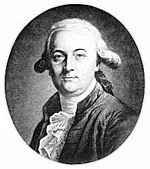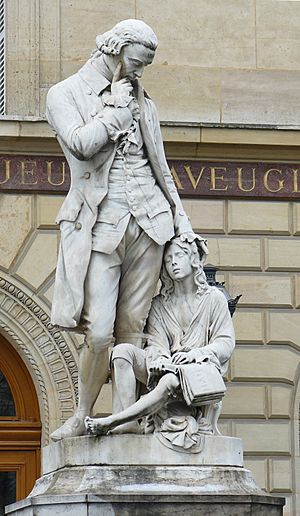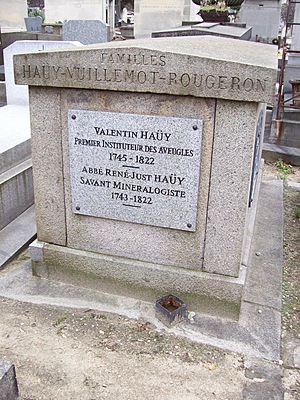Valentin Haüy facts for kids
Quick facts for kids
Valentin Haüy
|
|
|---|---|

Valentin Haüy
|
|
| Born | 13 November 1745 Saint-Just-en-Chaussée, Oise, France
|
| Died | 19 March 1822 (aged 76) Paris, France
|
| Nationality | French |
| Known for | first school for the blind |
| Relatives | René Just Haüy |
Valentin Haüy (pronounced ah-WEE; born November 13, 1745 – died March 19, 1822) was a very important person in history. In 1785, he started the world's first school for blind people. This school was called the Institute for Blind Youth in Paris. Today, it is known as the Institut National des Jeunes Aveugles, or the National Institute for the Young Blind. A famous student named Louis Braille joined this school in 1819.
Contents
Valentin Haüy's Life Story
Valentin Haüy grew up in a family of weavers. His father worked with looms and also rang the church bells at a nearby abbey. Monks at the abbey helped educate young Valentin. He became very good at languages, learning ten different ones. He also studied ancient Greek and Hebrew.
In 1783, he became an "interpreter to the king," King Louis XVI. By 1786, he was also an interpreter for the King's navy and the city government. He was a member of the Office of Writing, which shows his skill with words.
How He Decided to Help the Blind
Valentin Haüy's idea to help blind people began in 1771. He was having lunch in Paris when he saw a group of blind people being made fun of. They were from a place called the Quinze-Vingts hospice, which cared for the blind. During a street festival, these blind individuals were given silly hats and big cardboard glasses. They were told to play their instruments, which sounded like a lot of noise. This sad sight made Haüy want to do something truly helpful for them. He decided to start a school with Charles-Michel de l'Épée, who was known for helping deaf people.
Starting the First School
In May 1784, Haüy met a young beggar named François Lesueur. François became Valentin's very first student. Haüy created a special way of teaching by using raised letters. This allowed François to learn to read and write sentences by touching the letters. François learned very quickly! Haüy shared his success in a newspaper in September 1784, and the French Academy of Sciences encouraged his work.
With help from a group called the Philanthropic Society, Haüy officially opened the Institute for Blind Youth in February 1785. The school also received support from King Louis XVI. On December 26, 1786, it became the Royal Institution of Blind Children. The school's goal was to teach students and help them learn useful skills like spinning and printing. During the French Revolution, the government took over the school in 1791. It became the National Institute of Blind Workers.
Challenges and New Schools
Valentin Haüy was involved in the politics of his time. He faced some challenges during the French Revolution. He was arrested a few times but was always released. In 1802, he retired from managing the Blind Asylum and received a pension.
After retiring, he opened a private school in Paris in February 1802. Then, in September 1806, he moved to Saint Petersburg in Russia. He went there because Emperor Alexander I asked him to start a school for the blind in Russia.
He returned to Paris in 1817. He lived with his brother, René Just Haüy, who is famous for being one of the founders of modern mineralogy (the study of minerals).
Valentin Haüy is buried with his brother René in the Père Lachaise Cemetery in Paris.
His Lasting Impact
In 1889, a man named Maurice de La Sizeranne created an organization to help blind and visually impaired people. He named this organization after Valentin Haüy, showing how important Haüy's work was.
More to Explore
- Louis Braille
- Association Valentin Haüy
- Musée Valentin Haüy
- Slate and stylus, History
- fr :Association Valentin Haüy
See also
 In Spanish: Valentin Haüy para niños
In Spanish: Valentin Haüy para niños



